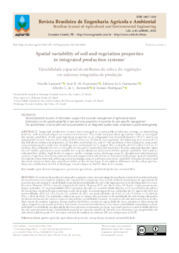Spatial variability of soil and vegetation properties in integrated production systems.
Spatial variability of soil and vegetation properties in integrated production systems.
Author(s): LAURENTI, N.; PEZZOPANE, J. R. M.; GUIMARAES, E. da S.; BERNARDI, A. C. de C.; RODRIGUES, J.
Summary: Integrated production systems have emerged as a sustainable production strategy in intensifying land use with minimal impact on ecosystem functions. This study used precision agriculture tools to investigate the spatial variability of soil and vegetation properties in an integrated crop-livestock-forestry (ICLF) and in an integrated livestock-forestry (ILF) area of São Carlos city, SP, Brazil. Consequently, the following were assessed: (1) the soil physicochemical properties, (2) the electrical resistivity, and (3) the attributes of the Eucalyptus urograndis crop comprising the study area. Samplings were performed in (1) August 2021 at depths of 0-0.2 and 0.2-0.4 m; (2) October 2021 at depths of 0-0.5, 0-1.0, and 0-2.0 m; and (3) April 2021 and April 2022. Results indicated that the values for soil fertility parameters were suitable for crop development and presented low spatial variability. Soil analyses indicated low acidity, high levels of organic matter, average cation exchange capacity, phosphorus and potassium contents, high base saturation, and calcium and magnesium levels. However, locations with greater spatial variability for calcium were observed, reflecting cation exchange capacity and base saturation variability. Soil granulometry and electrical resistivity had a low spatial variability at the surface layer. Even without differences in the soil properties, there was a difference of 15% in the larger wood volume in the ILF then ICLF system.
Publication year: 2024
Types of publication: Journal article
Observation
Some of Embrapa's publications are published as ePub files. To read them, use or download one of the following free software options to your computer or mobile device. Android: Google Play Books; IOS: iBooks; Windows and Linux: Calibre.
Access other publications
Access the Agricultural Research Database (BDPA) to consult Embrapa's full library collection and records.
Visit Embrapa Bookstore to purchase books and other publications sold by Embrapa.

